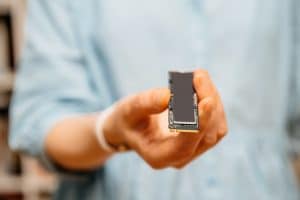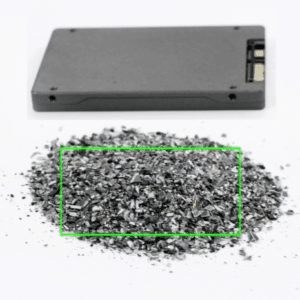 Organizations frequently use paper shredders and computer media destroyers that are approved for the highest security materials they ever have, using that equipment for all of their materials in a single stream process. Also common is to get the highest security level device that is available, even it goes well beyond the level of destruction mandated for or customarily used for the materials they actually have. This could be called a “better safe than sorry” philosophy for media destruction.
Organizations frequently use paper shredders and computer media destroyers that are approved for the highest security materials they ever have, using that equipment for all of their materials in a single stream process. Also common is to get the highest security level device that is available, even it goes well beyond the level of destruction mandated for or customarily used for the materials they actually have. This could be called a “better safe than sorry” philosophy for media destruction.
For some information destruction equipment, like office paper shredders, choosing the most secure equipment for everything can often work out alright. This choice will almost always be more costly than selecting the minimum security level device for each type of material for which it will be used. However, a greater cost is often accepted in return for the confidence of having the greatest possible degree of information destruction. For paper shredders, the highest security level means the smallest particle size, typically produced by NSA listed models.
 The situation for solid state media destroyers is very different. As a rule, dramatically greater hassle and cost will come from choosing the most secure possible device. Solid state materials include whole solid state drives, flash memory sticks, thumb drives, circuit boards with flash storage, cell phones, and some smart cards. The highest security level for destroying these types of materials is the NSA standard, currently set at a maximum of 4mm squared, with compliant devices typically producing a particle size of 2mm x 2mm. This particle size is required by the NSA for classified solid state items.
The situation for solid state media destroyers is very different. As a rule, dramatically greater hassle and cost will come from choosing the most secure possible device. Solid state materials include whole solid state drives, flash memory sticks, thumb drives, circuit boards with flash storage, cell phones, and some smart cards. The highest security level for destroying these types of materials is the NSA standard, currently set at a maximum of 4mm squared, with compliant devices typically producing a particle size of 2mm x 2mm. This particle size is required by the NSA for classified solid state items.
At the time I am writing this, the choices for NSA listed SSD destroyers are minimal. There is only one office friendly device with extremely limited capabilities. There are also a couple of large industrial type devices suited for folks with large spaces and large budgets. With the current set of choices, getting an NSA listed SSD destroyer means enormous costs. Adding to the large initial cost, operational labor (due to very slow throughput), replacement parts, repairs, and preventive maintenance are very high for these machines.
 The reality is that many organizations don’t need an NSA level of destruction for all of their solid state materials. Often the classified items are only a very limited part of the mix. In these cases, there are a few ways to save a lot of money and hassle. If none of the solid state items to be destroyed are actually classified, there are machines that are many times faster, much more rugged, and are a small fraction of the cost of the NSA listed machines. These devices produce high to extreme levels of destruction, well beyond any reasonable likelihood of reconstruction of any data. If only a portion of the items in the mix is classified material, a major bump in productivity plus significant savings can come from using one of these lower cost devices for the unclassified items. Even if an NSA listed SSD destroyer is brought in, the load on it can be reduced by using a second machine for the unclassified materials. This type of dual stream process can save many times the cost of the second machine in terms of reduced purchases of repairs, maintenance, and spare parts.
The reality is that many organizations don’t need an NSA level of destruction for all of their solid state materials. Often the classified items are only a very limited part of the mix. In these cases, there are a few ways to save a lot of money and hassle. If none of the solid state items to be destroyed are actually classified, there are machines that are many times faster, much more rugged, and are a small fraction of the cost of the NSA listed machines. These devices produce high to extreme levels of destruction, well beyond any reasonable likelihood of reconstruction of any data. If only a portion of the items in the mix is classified material, a major bump in productivity plus significant savings can come from using one of these lower cost devices for the unclassified items. Even if an NSA listed SSD destroyer is brought in, the load on it can be reduced by using a second machine for the unclassified materials. This type of dual stream process can save many times the cost of the second machine in terms of reduced purchases of repairs, maintenance, and spare parts.
When it comes to solid state media destruction, for folks whose materials are all or mostly unclassified, going with general purpose SSD destroyers offers these benefits over NSA listed SSD destroyers:
- Up to 20 times faster throughput
- Minimal service needs, even zero service needs through thousands of cycles
- Ability for most models to take whole SSDs with no assembly
- Models that run off of regular 120V wall current
- Dramatically lower cost for the equipment, ongoing service, and parts
Of course, technologies change over time. New products will surely come out. NSA certifications will change. It is a moving parade over longer time scales. But, for now, a great strategy for dealing with solid state media destruction that is partly or totally unclassified is to get a good general purpose SSD destroyer that provides a satisfactory level of destruction.
 Bob Glicker, Mid-Atlantic Regional Sales Manager, has over 35 total years of sales experience with over 23 years of targeted government sales experience. Bob prides himself on providing the highest level of service to his government clients, and he enjoys working with key resellers. Bob received his BS in Chemistry from the University of Maryland, College Park. In his free time, Bob enjoys a variety of activities including gym workouts, cycling, reading, and listening to podcasts. He is also an avid science lover, an amateur juggler, a vegetarian, and the quintessential family guy.
Bob Glicker, Mid-Atlantic Regional Sales Manager, has over 35 total years of sales experience with over 23 years of targeted government sales experience. Bob prides himself on providing the highest level of service to his government clients, and he enjoys working with key resellers. Bob received his BS in Chemistry from the University of Maryland, College Park. In his free time, Bob enjoys a variety of activities including gym workouts, cycling, reading, and listening to podcasts. He is also an avid science lover, an amateur juggler, a vegetarian, and the quintessential family guy.

